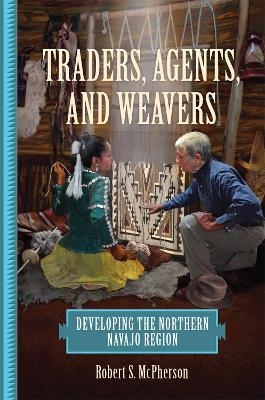
Traders, Agents, and Weavers
Developing the Northern Navajo Region
Seiten
2020
University of Oklahoma Press (Verlag)
978-0-8061-6479-3 (ISBN)
University of Oklahoma Press (Verlag)
978-0-8061-6479-3 (ISBN)
For travellers passing through northern Navajo country, the landscape appears desolate. The remaining Navajo trading posts unimpressive. Yet a closer look at the economic and creative activity in this region belies a more interesting picture. Robert McPherson unveils the history of the merging of cultures and artistic innovation across this land.
For travelers passing through northern Navajo country, the desert landscape appears desolate. The few remaining Navajo trading posts, once famous for their bustling commerce, seem unimpressive. Yet a closer look at the economic and creative activity in this region, which straddles northeastern Arizona, northwestern New Mexico, and southeastern Utah, belies a far more interesting picture. In Traders, Agents, and Weavers, Robert S. McPherson unveils the fascinating - and at times surprising - history of the merging of cultures and artistic innovation across this land.
McPherson, the author of numerous books on Navajo and southwestern history, narrates here the story of Navajo economic and cultural development through the testimonies of traders, government agents, tribal leaders, and accomplished weavers. For the first half of the twentieth century, trading posts dominated the Navajo economy in northwestern New Mexico. McPherson highlights the Two Grey Hills post and its sister posts Toadlena and Newcomb, which encouraged excellence among weavers and sold high-quality rugs and blankets. Parallel to the success of the trading industry was the establishment of the Northern Navajo or Shiprock Agency and Boarding School. The author explains the pivotal influence on the area of the agency's stern and controversial founder, William T. Shelton, known by Navajos as Tall Leader.
Through cooperation with government agents, American settlers, and traders, Navajo weavers not only succeeded financially but also developed their own artistic crafts. Shunning the use of brightly dyed yarn and opting for the natural colors of sheep's wool, these weavers, primarily women, developed an intricate style that has few rivals. Eventually, economic shifts, including oil drilling and livestock reduction, eroded the traditional Navajo way of life and led to the collapse of the trading post system. Nonetheless, as McPherson emphasizes, Navajo weavers have maintained their distinctive style and method of production to this day.
For travelers passing through northern Navajo country, the desert landscape appears desolate. The few remaining Navajo trading posts, once famous for their bustling commerce, seem unimpressive. Yet a closer look at the economic and creative activity in this region, which straddles northeastern Arizona, northwestern New Mexico, and southeastern Utah, belies a far more interesting picture. In Traders, Agents, and Weavers, Robert S. McPherson unveils the fascinating - and at times surprising - history of the merging of cultures and artistic innovation across this land.
McPherson, the author of numerous books on Navajo and southwestern history, narrates here the story of Navajo economic and cultural development through the testimonies of traders, government agents, tribal leaders, and accomplished weavers. For the first half of the twentieth century, trading posts dominated the Navajo economy in northwestern New Mexico. McPherson highlights the Two Grey Hills post and its sister posts Toadlena and Newcomb, which encouraged excellence among weavers and sold high-quality rugs and blankets. Parallel to the success of the trading industry was the establishment of the Northern Navajo or Shiprock Agency and Boarding School. The author explains the pivotal influence on the area of the agency's stern and controversial founder, William T. Shelton, known by Navajos as Tall Leader.
Through cooperation with government agents, American settlers, and traders, Navajo weavers not only succeeded financially but also developed their own artistic crafts. Shunning the use of brightly dyed yarn and opting for the natural colors of sheep's wool, these weavers, primarily women, developed an intricate style that has few rivals. Eventually, economic shifts, including oil drilling and livestock reduction, eroded the traditional Navajo way of life and led to the collapse of the trading post system. Nonetheless, as McPherson emphasizes, Navajo weavers have maintained their distinctive style and method of production to this day.
Robert S. McPherson is Professor of History Emeritus at Utah State University-Blanding Campus. He is the author or coauthor of numerous books on Navajo history and the history of the Southwest, including Under the Eagle: Samuel Holiday, Navajo Code Talker (with Samuel Holiday) and Viewing the Ancestors: Perceptions of the Anaasází, Mokwic, and Hisatsinom.
| Erscheinungsdatum | 01.04.2020 |
|---|---|
| Zusatzinfo | 21 black & white illustrations, 1 map |
| Verlagsort | Oklahoma |
| Sprache | englisch |
| Maße | 152 x 229 mm |
| Gewicht | 676 g |
| Themenwelt | Geisteswissenschaften ► Geschichte ► Allgemeine Geschichte |
| Geisteswissenschaften ► Geschichte ► Regional- / Ländergeschichte | |
| Geschichte ► Teilgebiete der Geschichte ► Kulturgeschichte | |
| Sozialwissenschaften ► Ethnologie | |
| Sozialwissenschaften ► Soziologie | |
| ISBN-10 | 0-8061-6479-4 / 0806164794 |
| ISBN-13 | 978-0-8061-6479-3 / 9780806164793 |
| Zustand | Neuware |
| Haben Sie eine Frage zum Produkt? |
Mehr entdecken
aus dem Bereich
aus dem Bereich
der stille Abschied vom bäuerlichen Leben in Deutschland
Buch | Hardcover (2023)
C.H.Beck (Verlag)
23,00 €
vom Mittelalter bis zur Gegenwart
Buch | Softcover (2024)
C.H.Beck (Verlag)
12,00 €


